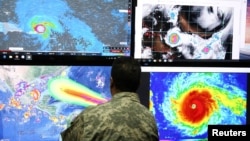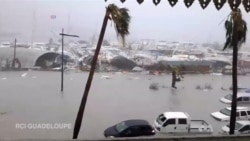Hurricane Irma moved through the northern Leeward Islands early Wednesday, bringing its Category 5 winds, dangerous storm surge and flooding rains directly across Barbuda.
The U.S. National Hurricane Center said forecasters expect the "extremely dangerous core" of the storm to move over or close to Anguilla, and the U.S. and British Virgin Islands during the day Wednesday before going near Puerto Rico by Wednesday night.
Predicting the hurricane's path later in the week is more difficult, but hurricane warnings have been posted for the Dominican Republic, the Southeastern Bahamas and the Turks and Caicos Islands, while watches are in place for Haiti and Cuba. The NHC said Irma is expected to remain a powerful Category 4 or 5 storm during the next few days.
"It’s the Leeward Islands and Puerto Rico in its line of fire and then we go into the Dominican Republic and Haiti," National Hurricane Center spokesman Dennis Feltgen told VOA. "Then we’re looking at the Bahamas, northern coast of Cuba, and eventually portions of south Florida. There’s an awful lot of real estate in front of Irma."
Early Wednesday, Irma had sustained winds of 295 kilometers per hour, making it one of the strongest Atlantic hurricanes in history.
Feltgen said there are very few things that can withstand winds that strong, meaning Irma has the potential to cause "catastrophic damage."
Forecasters said the hurricane could also bring storm surges of two to six meters to the islands along its path, as well as rainfall of 20 to 30 centimeters with isolated areas getting as much as 50 centimeters. The result could be life-threatening flooding and mudslides.
U.S. President Donald Trump has declared states of emergency in Puerto Rico, the U.S. Virgin Islands and Florida, and has ordered the Federal Emergency Management Agency (FEMA) to begin relief efforts.
In a Wednesday morning tweet, Trump said the federal government is poised to provide rescue and relief efforts in response to Irma.
"Watching Hurricane closely," Trump wrote in a Wednesday morning Tweet. "My team, which has done, and is doing, such a good job in Texas, is already in Florida. No rest for the weary," he added.
Irma's forecast track shows the storm hitting or passing close to Florida still as a major hurricane sometime around Sunday. But the uncertainty in predicting a hurricane's movements that far out leave the potential for it to shift, with eastward movement putting the Bahamas more at risk, while a more westward track would shift the risk of landfall from south Florida to the state's panhandle.
Governor Rick Scott has declared a state of emergency across all of Florida and ordered tourists to leave the Florida Keys island chain.
A catastrophic strike on Florida would add to the challenges faced by FEMA, which is already helping parts of southeast Texas clean up and repair damage from Hurricane Harvey, a Category 4 storm that hit August 25 and dropped a record amount of rain.














